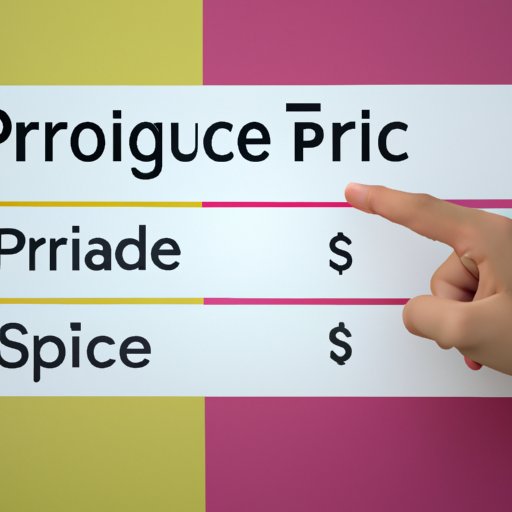Introduction
Starting a resale business can be an exciting and rewarding venture. With the right approach and strategy, you can make a nice profit from reselling items. But before you jump in, it’s important to understand what a resale business is and the benefits of starting one.
What is a Resale Business?
A resale business involves buying items at wholesale or discounted prices and then selling them at a markup. You can choose to specialize in a certain type of product – such as vintage clothing – or you can offer a variety of items. The key is to find quality products at low prices that you can sell for a profit.

Benefits of Starting a Resale Business
There are many benefits to starting a resale business. For one, it’s relatively inexpensive to get started since you don’t need to manufacture anything. Additionally, you have the potential to make a good profit if you can source quality items at low prices. Finally, you can get creative with your business by offering unique items and providing top-notch customer service.
Research the Resale Market
Before you get started, it’s important to do some research on the resale market. This will help you determine what type of items are in demand, who your potential customers are, and who your competition is.
Determine what Items are in Demand
Take some time to research what types of items people are looking for. If possible, try to focus on items that are in high demand and don’t require a lot of maintenance or upkeep. Additionally, look for items that have a wide price range so you can appeal to different budgets.
Identify Potential Customers
It’s also important to determine who your potential customers are. Think about who would be interested in the types of items you plan to sell and where they can be found. Are they online shoppers or do they prefer to shop in person? Knowing your target audience will help you create a more effective marketing plan.
Analyze Competition
Finally, take some time to analyze your competition. Look at what other businesses in your area are doing and see how you can differentiate yourself. Also, pay attention to their pricing structure and see if there are any areas where you can offer better value.
Create a Business Plan
Once you’ve done your research, it’s time to create a business plan. A business plan is a roadmap that outlines your goals, strategies, and resources. It will help you stay focused and organized as you launch your business.
Outline Your Strategy
Start by outlining your overall strategy. This should include your mission statement, your target market, and your long-term goals. Additionally, you should include information about your budget, your sources of inventory, and your pricing structure.
Set a Budget
Next, set a budget for your business. This should include your startup costs, such as your point-of-sale system and website, as well as your operational costs, such as inventory and marketing. Make sure to factor in any potential losses or unsold items.
Find a Reliable Source of Inventory
Once you’ve created your business plan, it’s time to find a reliable source of inventory. There are several options available, including wholesalers, suppliers, auction houses, and estate sales.
Consider Wholesalers and Suppliers
Wholesalers and suppliers are great sources for bulk orders of new items. They often offer discounts for large orders and can provide helpful advice about what types of items are in demand. However, keep in mind that these items may not be as unique as those found at estate sales or auctions.
Consider Auction Houses and Estate Sales
If you’re looking for unique items, auction houses and estate sales can be great sources. These can be a bit more time-consuming, but they can yield great deals on one-of-a-kind items. Plus, you can often buy items in bulk at a discounted rate.

Decide on a Pricing Structure
Once you’ve found a source of inventory, it’s time to decide on a pricing structure. This will determine how much you charge for each item and how much profit you make.
Understand Your Costs
First, you need to understand your costs. This includes the cost of the item, any shipping or handling fees, and any taxes. Once you know your total costs, you can calculate your desired markup.
Factor in Competition
Next, you should factor in competition. Research what similar items are selling for and price your items accordingly. Don’t forget to consider the value your item adds to the customer. For example, if you’re selling vintage items, the value could lie in their uniqueness or craftsmanship.
Consider the Value to Your Customer
Finally, consider the value your item brings to the customer. Don’t just focus on the price; think about the quality of the item, the level of customer service you provide, and any extras you offer. For example, if you offer free shipping or a satisfaction guarantee, this can add value to your item and make customers more likely to purchase from you.
Invest in a Point-of-Sale System
Once you’ve determined your pricing structure, you’ll need to invest in a point-of-sale (POS) system. A POS system is a computerized system that allows you to track sales and manage inventory. It’s essential for any retail business.
Understand What You Need
Before investing in a POS system, it’s important to understand what you need. Do you need a system that can handle multiple locations? Or do you just need basic features such as inventory tracking and sales reports? Knowing your needs will help you choose the right system.
Determine What Software is Right for You
Once you know what you need, you can start researching different software options. Consider factors such as cost, ease of use, and customer support. Try to get a demo version of the software before making a purchase to make sure it meets your needs.

Set Up an Online Store
In addition to a brick-and-mortar store, you should also consider setting up an online store. An online store can help you reach a wider audience and increase your profits.
Choose a Platform
The first step is to choose an ecommerce platform, such as Shopify or BigCommerce. These platforms make it easy to set up and manage an online store. Research different options and compare features to find the best fit for your business.
Build Your Website
Once you’ve chosen a platform, you can start building your website. Make sure to include detailed product descriptions, photos, and reviews. Additionally, you should include contact information, return policies, and payment options.
Make Sure You’re Secure
Finally, make sure your website is secure. Invest in a secure hosting plan and use secure payment processing services. Additionally, you should consider adding a privacy policy and terms and conditions page.
Promote Your Business
Once your business is up and running, you’ll need to promote it. There are several ways to do this, including social media, email marketing, and local advertising.
Utilize Social Media
Social media is a great way to reach potential customers. Create profiles on popular platforms such as Facebook and Instagram and post regularly. You can also use social media to host giveaways or contests to generate interest in your business.
Use Other Marketing Channels
In addition to social media, you should consider using other marketing channels. For example, you can use email newsletters to keep customers up-to-date on new products and promotions. You can also use print advertising or direct mail to reach local customers.
Conclusion
Starting a resale business can be a profitable venture. To get started, you’ll need to do research on the market, create a business plan, find a reliable source of inventory, decide on a pricing structure, invest in a POS system, set up an online store, and promote your business. By following these steps, you can get your business up and running in no time.
(Note: Is this article not meeting your expectations? Do you have knowledge or insights to share? Unlock new opportunities and expand your reach by joining our authors team. Click Registration to join us and share your expertise with our readers.)
